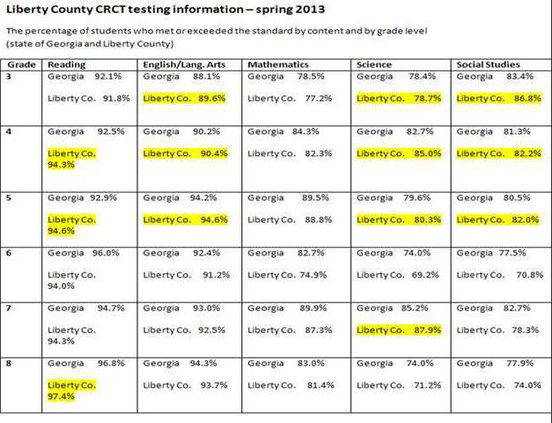The Georgia Department of Education on Tuesday announced that Georgia students improved performance in 18 of 30 content areas on the 2013 Criterion Referenced Competency Test scores.
The news also came with the release of statewide averages and district scores, according to a release on www.doe.k12.ga.us. Individual school scores will be released no later than July 10.
“Our results this year on the CRCT show consistent progress, and we continue to see many students scoring in the exceeds category,” state School Superintendent Dr. John Barge said. “This is a testament to the great work our teachers are doing to take students to higher levels of learning.”
So how does Liberty County fare compared to the state averages?
Carol Spurlin, the district’s director of title programs, provided district officials with a consolidated report of reading, language arts, science, social studies and math scores for grades three through eight.
Liberty County students met or exceeded content-area standards at a greater rate than the statewide average on 13 tests, according to the data. Mathematics was the only test area in which none of the Liberty averages were higher than the state’s.
Spurlin said math always has been an issue for the district, and the data is evidence that it will remain an area of focus.
With administrative changes afoot and district curriculum specialists Susan Norce and Susan Avant both out of the office for two weeks, Deputy Superintendent Dr. Cheryl Conley on Wednesday was the best-equipped source to speak about the scores.
Conley first evaluated the data by grade level, then by subject area.
“Third grade looks good because we’re either above the state or right below; fourth grade looks good; fifth grade looks very, very good,” Conley said. “But where we start running into a little problem is at sixth grade, and then specifically at math, science and social studies.”
The greatest disparity between state and district averages was among sixth-grade math, science and social studies, with respective differences of 7.8 percent, 4.8 percent and 6.7 percent.
When Georgia rolled out its first-ever College and Career Ready Performance Index school grades in early May, Liberty’s aggregate middle-school score fell below the state average.
When asked whether the CCRPI score and the CRCT performance for middle schools were directly correlated, Conley said the items are pieces to a larger puzzle.
And it’s one that merits more probing.
“I’m not sure what happens from fifth grade to sixth grade,” she said. “This is where you start to drill it down. You look at it, you analyze it and then you drill it down to see, ‘Why do we have such a big jump from here to here?’
“It could be a difference in the curriculum, it could be a change in the curriculum, because when you go from one curriculum to another, some of the skills get moved to another grade and some people lose the skills.”
But, she added, student performance among seventh- and eighth-graders was higher, which is an indication that sixth-grade teachers are preparing their students.
In reading, the percent meeting or exceeding the standard for grades four, five and eight was greater than respective state averages. Sixth grade fell 2 percent below the state, while seventh was 0.4 percent.
For English/language arts, third-, fourth- and fifth-graders exceeded the state, and the ones who did not were within 1.2 percent of the state average.
In science, third through fifth grades and seventh grade exceeded state averages, and in social studies, third through fifth grades again performed better.
The next steps, Conley said, are to evaluate the scores on a school-level basis and then address individual student performance.
“If you can target a student’s weaknesses and remediate an individual student’s weaknesses, then all the scores come up,” she said.
Liberty schools beat state on tests


Sign up for our e-newsletters